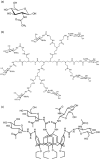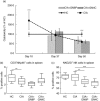Collagen-induced arthritis: severity and immune response attenuation using multivalent N-acetyl glucosamine
- PMID: 24588081
- PMCID: PMC4089161
- DOI: 10.1111/cei.12313
Collagen-induced arthritis: severity and immune response attenuation using multivalent N-acetyl glucosamine
Abstract
Rheumatoid arthritis is an autoimmunity leading to considerable impairment of quality of life. N-acetyl glucosamine (GlcNAc) has been described previously as a potent modulator of experimental arthritis in animal models and is used for osteoarthritis treatment in humans, praised for its lack of adverse effects. In this study we present a comprehensive immunological analysis of multivalent GlcNAc-terminated glycoconjugate (GC) application in the treatment of collagen-induced arthritis (CIA) and its clinical outcome. We used immunohistochemistry and FACS to describe conditions on the inflammation site. Systemic and clinical effects were evaluated by FACS, cytotoxicity assay, ELISA, cytometric bead array (CBA), RT-PCR and clinical scoring. We found reduced inflammatory infiltration, NKG2D expression on NK and suppression of T, B and antigen-presenting cells (APC) in the synovia. On the systemic level, GCs prevented the activation of monocyte- and B cell-derived APCs, the rise of TNF-α and IFN-γ levels, and subsequent type II collagen (CII)-specific IgG2a formation. Moreover, we detected an increase of anti-inflammatory IL-4 mRNA in the spleen. Similar to the synovia, the GCs caused a significant reduction of NKG2D-expressing NK cells in the spleen without influencing their lytic function. GCs effectively postponed the onset of arthritic symptoms, reduced their severity and in 18% (GN8P) and 31% (GN4C) of the cases completely prevented their appearance. Our data prove that GlcNAc glycoconjugates prevent the inflammatory response, involving proinflammatory cytokine rise, APC activation and NKG2D expression, leading to the attenuation of clinical symptoms. These results support the glycobiological approach to the treatment of collagen-induced arthritis/rheumatoid arthritis (CIA/RA) as a way of bringing new prospects for more effective therapeutic interventions.
Keywords: CIA; GlcNAc glycoconjugates; clinical scoring; cytokines; humoral response.
© 2014 British Society for Immunology.
Figures









Similar articles
-
Blockade of NKG2D ameliorates disease in mice with collagen-induced arthritis: a potential pathogenic role in chronic inflammatory arthritis.Arthritis Rheum. 2011 Sep;63(9):2617-29. doi: 10.1002/art.30460. Arthritis Rheum. 2011. PMID: 21618462
-
Potential therapeutic effects of cyanidin-3-O-glucoside on rheumatoid arthritis by relieving inhibition of CD38+ NK cells on Treg cell differentiation.Arthritis Res Ther. 2019 Oct 28;21(1):220. doi: 10.1186/s13075-019-2001-0. Arthritis Res Ther. 2019. PMID: 31661005 Free PMC article.
-
Protection against cartilage and bone destruction by systemic interleukin-4 treatment in established murine type II collagen-induced arthritis.Arthritis Res. 1999;1(1):81-91. doi: 10.1186/ar14. Epub 1999 Oct 26. Arthritis Res. 1999. PMID: 11056663 Free PMC article.
-
Cells of the synovium in rheumatoid arthritis. B cells.Arthritis Res Ther. 2007;9(2):205. doi: 10.1186/ar2125. Arthritis Res Ther. 2007. PMID: 17349064 Free PMC article. Review.
-
Polymeric micro- and nanoparticles for immune modulation.Biomater Sci. 2018 Dec 18;7(1):14-30. doi: 10.1039/c8bm01285g. Biomater Sci. 2018. PMID: 30418444 Free PMC article. Review.
Cited by
-
In Vitro Antiviral and Anti-Inflammatory Activities of N-Acetylglucosamine: Development of an Alternative and Safe Approach to Fight Viral Respiratory Infections.Int J Mol Sci. 2023 Mar 7;24(6):5129. doi: 10.3390/ijms24065129. Int J Mol Sci. 2023. PMID: 36982205 Free PMC article.
-
Increased chemotaxis and activity of circulatory myeloid progenitor cells may contribute to enhanced osteoclastogenesis and bone loss in the C57BL/6 mouse model of collagen-induced arthritis.Clin Exp Immunol. 2016 Dec;186(3):321-335. doi: 10.1111/cei.12862. Epub 2016 Oct 18. Clin Exp Immunol. 2016. PMID: 27612450 Free PMC article.
-
Inhibitory effects of Acanthopanax sessiliflorus Harms extract on the etiology of rheumatoid arthritis in a collagen-induced arthritis mouse model.Arthritis Res Ther. 2024 Jan 2;26(1):11. doi: 10.1186/s13075-023-03241-1. Arthritis Res Ther. 2024. PMID: 38167214 Free PMC article.
-
Models for T-large granular lymphocytic leukemia: how to mimic the cellular interplays in malignant autoimmunity.Leukemia. 2025 Apr;39(4):792-804. doi: 10.1038/s41375-025-02553-2. Epub 2025 Mar 7. Leukemia. 2025. PMID: 40055531 Free PMC article. Review.
-
Dietary Natural N-Acetyl-d-Glucosamine Prevents Bone Loss in Ovariectomized Rat Model of Postmenopausal Osteoporosis.Molecules. 2018 Sep 9;23(9):2302. doi: 10.3390/molecules23092302. Molecules. 2018. PMID: 30205615 Free PMC article.
References
-
- Feldmann M. Pathogenesis of arthritis: recent research progress. Nat Immunol. 2001;2:771–773. - PubMed
-
- Ngian GS. Rheumatoid arthritis. Aust Fam Physician. 2010;39:626–628. - PubMed
-
- Azuma K, Osaki T, Wakuda T, et al. Suppressive effects of N-acetyl-D-glucosamine on rheumatoid arthritis mouse models. Inflammation. 2012;35:1462–1465. - PubMed
-
- Alavi A, Axford JS. Sweet and sour: the impact of sugars on disease. Rheumatology (Oxf) 2008;47:760–770. - PubMed
-
- Collins ES, Galligan MC, Saldova R, et al. Glycosylation status of serum in inflammatory arthritis in response to anti-TNF treatment. Rheumatology (Oxf) 2013;52:1572–1582. - PubMed
MeSH terms
Substances
Grants and funding
LinkOut - more resources
Full Text Sources
Other Literature Sources
Medical
Miscellaneous

